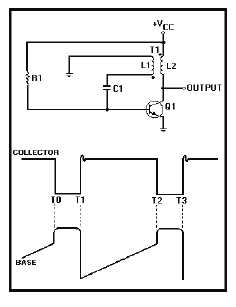27
Figure 3E.—Blocking oscillator.
IN ANSWERING QUESTIONS 3-32
THROUGH 3-37, REFER TO FIGURE 3E.
3-32. What is indicated by the dots at each end
of T1 in the figure?
1. 0-degree phase shift
2.
90-degree phase shift
3. 160-degree phase shift
4. 180-degree phase shift
3-33. Regenerative feedback to the base of Q1
is provided by what circuit
component(s)?
1. L1 only
2. L2 only
3. L1 and L2 only
4. L1, L2, and C1
3-34. What circuit action is taking place from
T0 to T1?
1. C1 is charging
2. C1 is discharging
3. L1 is discharging
4. IC is decreasing
3-35. THIS QUESTION HAS BEEN
DELETED.
3-36. During what total time period is Q1
blocked?
1. T0 to T1
2. T1 to T2
3. T0 to T2
4. T2 to T3
3-37. In the blocking oscillator, which of the
following circuit actions is the primary
cause of parasitic oscillations?
1. Collapse of the magnetic field of L1
2. Expansion of the magnetic field of L1
3. Inductive coupling between L1 and
L2
4. C1 discharging through Q1
3-38. Which of the following circuit actions is
a result of critical damping?
1. Rapid transient response without
overshoot
2. Rapid transient response with
overshoot
3. Slow transient response without
overshoot
4. Slow transient response with
overshoot
3-39. What type of damping is caused by (a)
high resistance and (b) low resistance?
1. (a) Overdamping
(b) Underdamping
2. (a) Underdamping
(b) Overdamping
3. (a) Critical damping
(b) Underdamping
4. (a) Overdamping
(b) Critical damping



